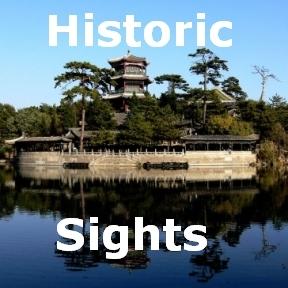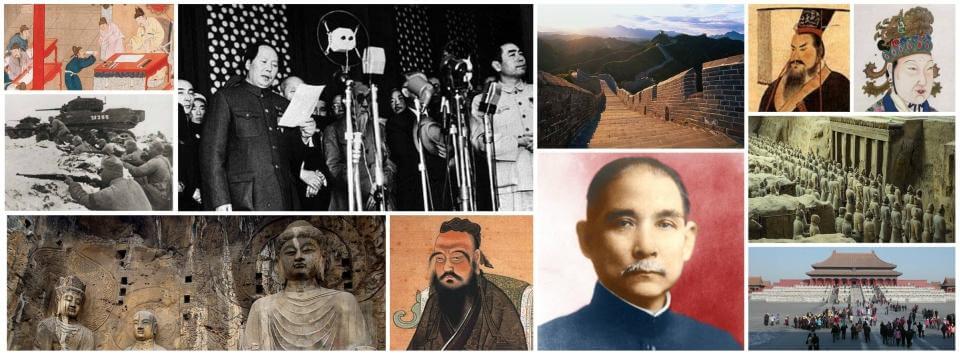
Yuan Dynasty (AD 1271 - 1368)
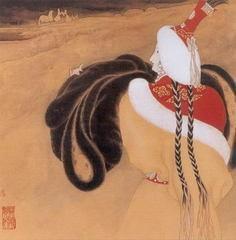 painting of Boerte, Genghis Khan's wifeThe rise of the Mongols out of the steppes of Central Asia at the end of the 12th and the beginning of the 13th century is closely connected with the story of one man. The young Temujin (AD 1162 - 1227) already had a conflict-ridden history behind him even before he was elected as the leader of all khans - Genghis Khan (literally: Oceanic Leader) - at the assembly of all Mongol tribes - Kurultai - in AD 1206.
painting of Boerte, Genghis Khan's wifeThe rise of the Mongols out of the steppes of Central Asia at the end of the 12th and the beginning of the 13th century is closely connected with the story of one man. The young Temujin (AD 1162 - 1227) already had a conflict-ridden history behind him even before he was elected as the leader of all khans - Genghis Khan (literally: Oceanic Leader) - at the assembly of all Mongol tribes - Kurultai - in AD 1206.
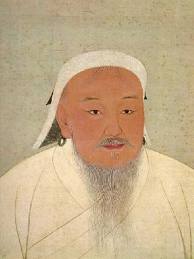 painting of Genghis KhanThe murder of his father (who was a minor tribal chieftain) in a feud among different Mongol leaders, the successive hiding out with his mother and siblings for several years, the temporary kidnapping of his wife Boerte (who had been promised to him in an agreement between his and her father when he was still an infant and who he had claimed when he was just sixteen years old) had all certainly influenced his character, whose viciousness became first apparent when he murdered his elder brothers sometime between the 1180s and 1190s in order to cement his leadership in the family. His successful raid to reclaim his wife brought him his first glory on the battlefield.
painting of Genghis KhanThe murder of his father (who was a minor tribal chieftain) in a feud among different Mongol leaders, the successive hiding out with his mother and siblings for several years, the temporary kidnapping of his wife Boerte (who had been promised to him in an agreement between his and her father when he was still an infant and who he had claimed when he was just sixteen years old) had all certainly influenced his character, whose viciousness became first apparent when he murdered his elder brothers sometime between the 1180s and 1190s in order to cement his leadership in the family. His successful raid to reclaim his wife brought him his first glory on the battlefield.
He used the subsequent years to form alliances with certain tribal leaders and became the leader of a tribal group - khan - by AD 1190. Around AD 1200, he began to pursue his goal of uniting the various Mongol tribes through political and military. This campaign already seemed to have ended in failure in AD 1204, when many of his allies deserted him and his forces were subsequently defeated in a great battle. However, he didn't give up his ambition and several months later an opportunity presented itself.
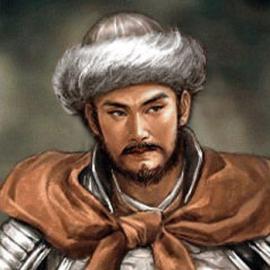 Jin Emperor XuanzongWhen his rivals staged a customary Mongol celebration, Temujin waited with his small army (perhaps 6000 warriors) until his enemies were incapacitated from too much food and drink before launching a surprise attack. Even though his forces were greatly outnumbered, the element of surprise and the reduced fighting ability of his rivals' army contributed to his victory after a battle of three days and nights. The next two years were spent consolidating his power before being elected as the leader of all the Mongols at the Kurultai in AD 1206.
Jin Emperor XuanzongWhen his rivals staged a customary Mongol celebration, Temujin waited with his small army (perhaps 6000 warriors) until his enemies were incapacitated from too much food and drink before launching a surprise attack. Even though his forces were greatly outnumbered, the element of surprise and the reduced fighting ability of his rivals' army contributed to his victory after a battle of three days and nights. The next two years were spent consolidating his power before being elected as the leader of all the Mongols at the Kurultai in AD 1206.
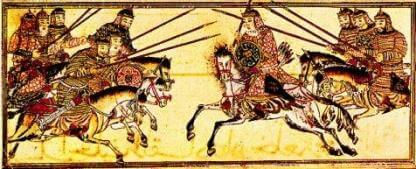 Mongol cavalry in a battleThe economy of the Mongol tribes was at that time, besides the meagre profits that the pastoral grazing of sheep and goats provided, largely based upon the accumulation of wealth through raiding neighbouring tribes (including other Mongol tribes). With all the Mongol tribes unified under the strong leadership of Genghis Khan, these internal raids were stopped and the Mongols used the following one to two years preparing the assault of their wealthy Southern neighbours.
Mongol cavalry in a battleThe economy of the Mongol tribes was at that time, besides the meagre profits that the pastoral grazing of sheep and goats provided, largely based upon the accumulation of wealth through raiding neighbouring tribes (including other Mongol tribes). With all the Mongol tribes unified under the strong leadership of Genghis Khan, these internal raids were stopped and the Mongols used the following one to two years preparing the assault of their wealthy Southern neighbours.
The Western Xia state in the Northwest of the Chinese heartland was the first state to fall victim to the Mongol onslaught and surrendered to the Mongols in AD 1209. After that, the Mongols started their raids against the Jin state north of the Southern Song empire. In AD 1215, Genghis besieged, captured and sacked the Jin capital of Zhongdu (modern-day Beijing). This forced the Jin Emperor Xuanzong to move his capital south to Kaifeng, abandoning the northern half of his kingdom to the Mongols.
After that, the wealthy states along the caravan routes of the ancient Silk Road in Central Asia fell prey to the Mongols, first the Western Liao dynasty (a.k.a. Kara-Khitan Khanate) in AD 1218 and then the Khwarazmian Empire in AD 1220/1221.
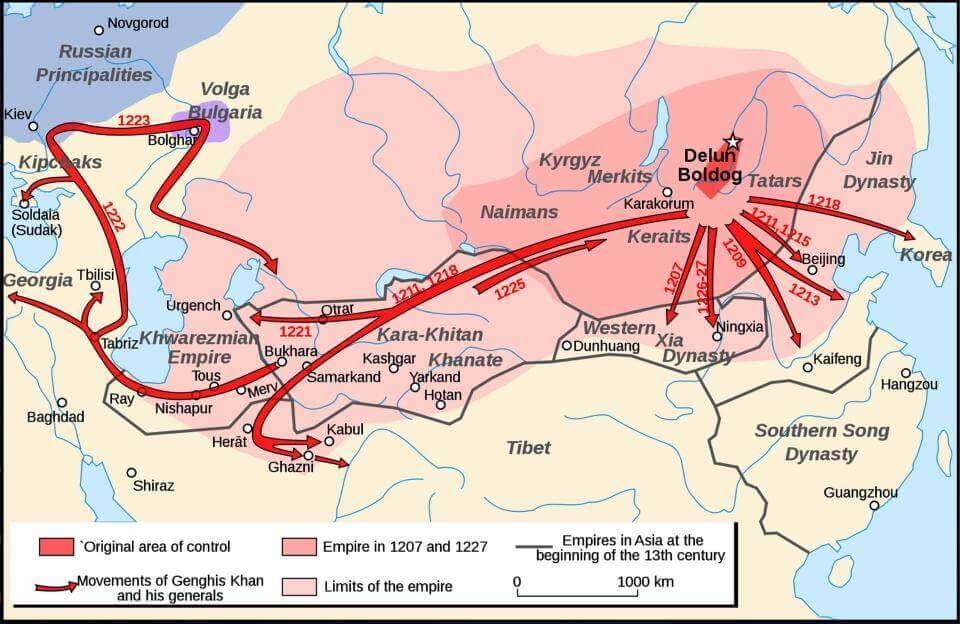 Map of the Mongol Empire in the 13th century
Map of the Mongol Empire in the 13th century
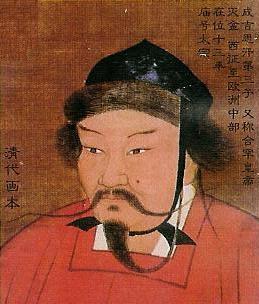 Genghis Khan's son ÖgedeiThe amazing success of the Mongols in battle was largely due to their supreme horsemanship and the resilience and hardiness of their small ponies. The ability of the Mongol cavalry to appear surprisingly out of nowhere, after up to four days of riding across great distances, often gave them the element of surprise. When the Mongol hordes showed up thus unexpected to besiege a city, their enemies had but two stark choices: surrender or die. Either way, the besieged city's wealth and women were taken and the enemy soldiers that hadn't been ruthlessly killed were incorporated into the Mongol army (with Mongols as the officers of the mixed troops).
Genghis Khan's son ÖgedeiThe amazing success of the Mongols in battle was largely due to their supreme horsemanship and the resilience and hardiness of their small ponies. The ability of the Mongol cavalry to appear surprisingly out of nowhere, after up to four days of riding across great distances, often gave them the element of surprise. When the Mongol hordes showed up thus unexpected to besiege a city, their enemies had but two stark choices: surrender or die. Either way, the besieged city's wealth and women were taken and the enemy soldiers that hadn't been ruthlessly killed were incorporated into the Mongol army (with Mongols as the officers of the mixed troops).
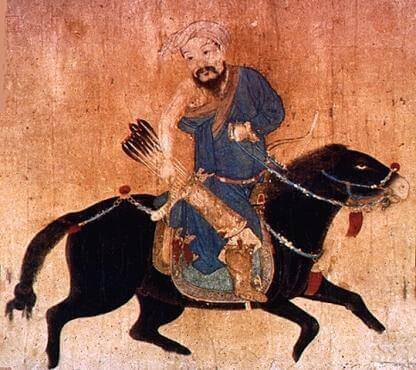 Ming dynasty painting of a Mongol light cavalrymanWhile continuing to harangue the Jin state, the Mongol empire quickly expanded towards Central Asia, Persia and Russia. Interestingly, Tibet's submission was won without ever having to invade it (many Mongols had adopted Tibetan Buddhism as their religion but Nestorian Christianity was also popular among them).
Ming dynasty painting of a Mongol light cavalrymanWhile continuing to harangue the Jin state, the Mongol empire quickly expanded towards Central Asia, Persia and Russia. Interestingly, Tibet's submission was won without ever having to invade it (many Mongols had adopted Tibetan Buddhism as their religion but Nestorian Christianity was also popular among them).
When Genghis Khan died in Central Asia just before the surrender of the Western Xia state on the way to return to his homeland in AD 1227, all the widely dispersed Mongol armies were quickly recalled from their campaigns. Genghis Khan's son Ögedei was elected as the new khan at the Kurultai in AD 1229.
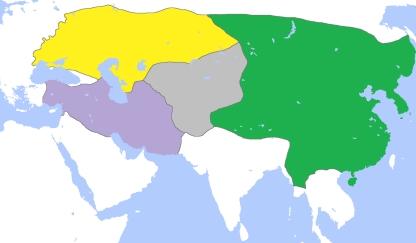 Map showing the division of the Mongol empire around AD 1300 into the territory of the Golden Horde (yellow), Chagatai Khanate (grey), Yuan Dynasty (green) and Ilkhanate (purple).Ögedei (reigned between AD 1229 - 1241) then launched a second great age of military conquest and it was just a few years after the start of his reign period in AD 1234 that the Jin state was defeated and incorporated into the Mongol empire.
Map showing the division of the Mongol empire around AD 1300 into the territory of the Golden Horde (yellow), Chagatai Khanate (grey), Yuan Dynasty (green) and Ilkhanate (purple).Ögedei (reigned between AD 1229 - 1241) then launched a second great age of military conquest and it was just a few years after the start of his reign period in AD 1234 that the Jin state was defeated and incorporated into the Mongol empire.
In this period, the Mongols continued their military conquests in Persia and Southern Russia and expanded their raids along the Western part of the Southern Song empire and as far away as Korea. This second period of great military expansion came to an end with Ögedei's death in AD 1241, when all the dispersed Mongol armies (parts of which were besieging Vienna) had to be called back yet again for another Kurultai. The division of the Mongol empire, that had already begun earlier, now accelerated in this period of internal political uncertainty and conflict and eventually resulted in a split into the following khanates:
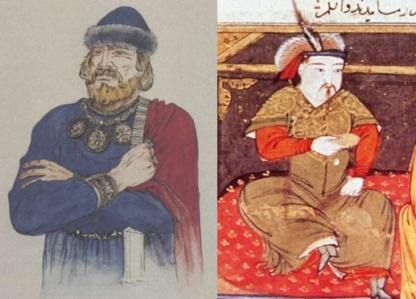 Left: Batu Khan, leader of the Khanate of the Golden Horde Right: 14th century painting of Hulegu Khan, the leader of the IlkhanateBatu Khan (ca. AD 1205 - 1255) obtained the "Khanate of the Golden Horde" - shown in yellow in the above map - that encompassed large areas of the territory that is now Russia and the Ukraine. The descendants of these Mongol tribes entered later European history as the Cossacks.
Left: Batu Khan, leader of the Khanate of the Golden Horde Right: 14th century painting of Hulegu Khan, the leader of the IlkhanateBatu Khan (ca. AD 1205 - 1255) obtained the "Khanate of the Golden Horde" - shown in yellow in the above map - that encompassed large areas of the territory that is now Russia and the Ukraine. The descendants of these Mongol tribes entered later European history as the Cossacks.
Hulegu (AD 1217 - 1265) obtained the "Ilkhanate" - shown in purple in the above map - within the former territory of Persia. The Ilkhan converted to Islam and its descendants invaded India, where they founded the Mughal dynasty, that flourished in the 16th century there and lasted until the colonization of India by the British in the 19th century.
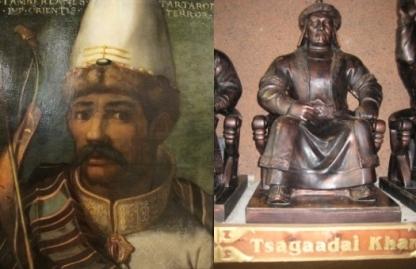 Left: 16th century painting of Tamerlane Right: Statue of Chagatai Khan, the leader of the Chagatai KhanateChagatai (reigned from AD 1226 - 1242) and his successors ruled the "Chagatai Khanate" - shown in grey in the above map - from the legendary city of Samarkand. In the next century, Chagatai's descendant Tamerlane (a.k.a. Timur, AD 1336 - 1405) became a famous historical figure as well. He is remembered for his plans to take back China from the Ming dynasty but his planned invasion ended on the territory of what is now Kazakhstan when he suddenly got sick and died.
Left: 16th century painting of Tamerlane Right: Statue of Chagatai Khan, the leader of the Chagatai KhanateChagatai (reigned from AD 1226 - 1242) and his successors ruled the "Chagatai Khanate" - shown in grey in the above map - from the legendary city of Samarkand. In the next century, Chagatai's descendant Tamerlane (a.k.a. Timur, AD 1336 - 1405) became a famous historical figure as well. He is remembered for his plans to take back China from the Ming dynasty but his planned invasion ended on the territory of what is now Kazakhstan when he suddenly got sick and died.
The eastern part of the Mongol empire (including the Korean peninsula) became the Yuan dynasty - shown in green in the above map - under the leadership of Kublai Khan (AD 1215 - 1294), one of Genghis Khan's grandsons. Even though Kublai proclaimed the founding of the Yuan dynasty (AD 1271 - 1368) in AD 1271 already, it took until AD 1279 for his army to vanquish the last forces of the Southern Song empire (See explanation underneath in this article).
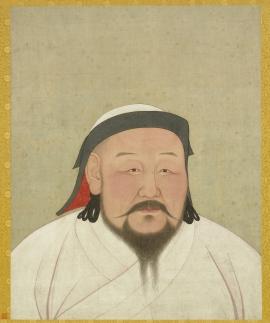 painting of Kublai Khan by the Nepalese artist Anige (an astronomer, engineer, painter, and confidant of Kublai Khan)The division of the vast Mongol empire into these four khanates greatly facilitated the communication and exchange between Southern and Eastern Europe with Central and East Asia. For the first time in history, it was relatively safe to travel from the Eastern Mediterranean along the ancient trade routes (Silk Road) all the way to China.
painting of Kublai Khan by the Nepalese artist Anige (an astronomer, engineer, painter, and confidant of Kublai Khan)The division of the vast Mongol empire into these four khanates greatly facilitated the communication and exchange between Southern and Eastern Europe with Central and East Asia. For the first time in history, it was relatively safe to travel from the Eastern Mediterranean along the ancient trade routes (Silk Road) all the way to China.
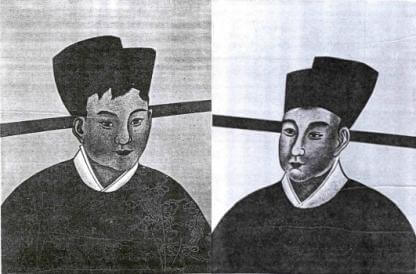 Left: Portrait of the Song Emperor Duanzong Right: Portrait of the Song Emperor GongThe leadership of Kublai Khan was influential in extending the realm of his Mongol Khanate all over China and the Korean peninsula. This age of conquest started after he had consolidated his power after becoming khan in AD 1260. In order to bring the territories of the Southern Song dynasty under his control, the Mongols had to fight a prolonged campaign and even had to bring in soldiers with experience in urban siege warfare and combat (the Chinese population of Southern China was not spread around evenly like on the North China Plain but was mainly concentrated in certain urban areas) from other parts of the vast Mongol empire (particularly from the Ilkhanate in Persia).
Left: Portrait of the Song Emperor Duanzong Right: Portrait of the Song Emperor GongThe leadership of Kublai Khan was influential in extending the realm of his Mongol Khanate all over China and the Korean peninsula. This age of conquest started after he had consolidated his power after becoming khan in AD 1260. In order to bring the territories of the Southern Song dynasty under his control, the Mongols had to fight a prolonged campaign and even had to bring in soldiers with experience in urban siege warfare and combat (the Chinese population of Southern China was not spread around evenly like on the North China Plain but was mainly concentrated in certain urban areas) from other parts of the vast Mongol empire (particularly from the Ilkhanate in Persia).
Moreover, the Mongol army had to learn to fight naval battles during its campaigns along the Yangtze River and the Chinese Great Lakes in the 1260s and early 1270s.
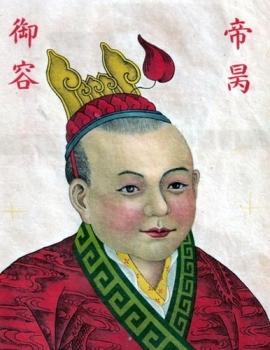 Portrait of the Song Emperor Bing, the last emperor of the Song dynastyThe five-year-old Emperor Gong of the Southern Song dynasty was captured and his army chased out of the Song capital Lin'an (nowadays Hangzhou) in AD 1276. His successors, first the ten-year-old Emperor Duanzong and then the eight-year-old Emperor Bing died in AD 1278 and 1279 respectively. With the last claimants to the Song throne dead, China was once more unified, albeit under a foreign ruler.
Portrait of the Song Emperor Bing, the last emperor of the Song dynastyThe five-year-old Emperor Gong of the Southern Song dynasty was captured and his army chased out of the Song capital Lin'an (nowadays Hangzhou) in AD 1276. His successors, first the ten-year-old Emperor Duanzong and then the eight-year-old Emperor Bing died in AD 1278 and 1279 respectively. With the last claimants to the Song throne dead, China was once more unified, albeit under a foreign ruler.
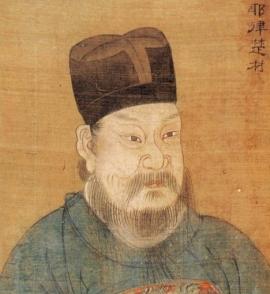 Portrait of Yelü Chucai, an administrator of the early Mongol EmpireStrangely, the Mongols had considered turning all of North China into pastureland for their ponies (and presumably wiping out the entire Chinese population). Luckily, the former Jin state official Yelü Chucai had convinced them that it would be much more beneficial to keep the Chinese population in place, so that they could continue to produce the agricultural wealth that the Mongols would then benefit from through taxation.
Portrait of Yelü Chucai, an administrator of the early Mongol EmpireStrangely, the Mongols had considered turning all of North China into pastureland for their ponies (and presumably wiping out the entire Chinese population). Luckily, the former Jin state official Yelü Chucai had convinced them that it would be much more beneficial to keep the Chinese population in place, so that they could continue to produce the agricultural wealth that the Mongols would then benefit from through taxation.
Just like the Mongol rulers of the Western parts of the vast Mongol empire, Kublai Khan tried to adapt his rule to the realities of the occupied lands by choosing the long-established Chinese dynastic model. The new capital of the Mongol Yuan dynasty (yuan = long lasting or far reaching) was built at the site that is now Beijing and the Chinese called it Dadu (great capital).
However, a considerable part of the Mongol occupiers saw it as sort of against their nature (as nomadic horsemen) to settle down domestically to rule the vast Chinese empire and they returned to their pastoral lifestyle in the steppes of Mongolia.
That left the problem of administering the new Chinese Yuan empire with a population of around 100 million people in the hands of perhaps one million widely dispersed Mongols. What's more, the traditional officials and administrators of China - the intellectual elite class of the literati - couldn't be trusted (and was resented) by the Mongols, since they had been the main organizers of the more than 20-years-long resistance of the Southern Song dynasty against the Mongol invaders. So, who could govern their vast empire? Most Mongols were illiterate and couldn't even read or write their own language, no less the high-brow Chinese discourse of the literati.
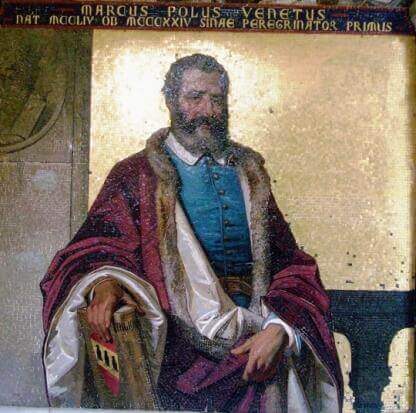 Mosaic representing Marco Polo at Villa Hanbury, Ventimiglia, ItalyIn order to find a way to access the necessary knowledge of the literati while keeping a watchful eye on them and without giving them too much influence, the Mongols started to bring people with proven administrative ability (even though usually unable to speak or write Chinese) from other parts of their empire to China and placed them in administrative positions with decision-making power alongside Chinese literati with clerical functions. Many of these foreign administrators came from the territories of Persia and Russia. Because of their different physical appearance (light colored hair and eyes), they were called semu ren - people with colored eyes - by the Chinese.
Mosaic representing Marco Polo at Villa Hanbury, Ventimiglia, ItalyIn order to find a way to access the necessary knowledge of the literati while keeping a watchful eye on them and without giving them too much influence, the Mongols started to bring people with proven administrative ability (even though usually unable to speak or write Chinese) from other parts of their empire to China and placed them in administrative positions with decision-making power alongside Chinese literati with clerical functions. Many of these foreign administrators came from the territories of Persia and Russia. Because of their different physical appearance (light colored hair and eyes), they were called semu ren - people with colored eyes - by the Chinese.
The famous Venetian Marco Polo (AD 1254 - 1324), who had left Venice in AD 1272 with his father and uncle in order to travel overland (through the Middle East and Central Asia) to China, was perhaps the most famous semu ren, after he accepted Kublai Khan's offer of employment within the Mongol administration. During his nearly twenty years in China, he served the Mongol rulers both on diplomatic missions (during one of which he escorted the bride procession of a Mongol princess) and as a local governor (of the wealthy city of Yangzhou).
After his overland return to Europe, he wrote a book about his experiences in the Middle Kingdom that came to be derisively known as "The Millions" (referring to the number of lies it supposedly contained) by his incredulous readers.
Working as clerks under the leadership of the semu ren became a character-defining experience for the educated literati and had profound cultural implications as well. Suddenly marginalized and deprived of any real power and decision-making authority, many educated gentlemen of the Chinese literati (who still saw themselves as the legitimate leaders of Chinese society in their minds) began to turn their energies away from governance and administration towards literature and the decorative arts.
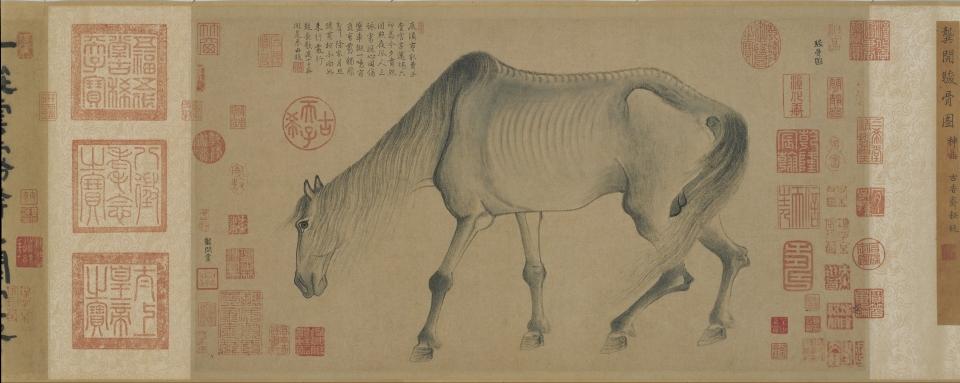 "Emaciated Horse" painting by Gong Kai (AD 1222 - 1307). After the Mongol army under Kublai Khan conquered the Southern Song Dynasty state in AD 1279, Gong Kai remained a Song loyalist and refused to serve Kublai's government. This painting of an emaciated horse represents his own poverty-stricken conditions that he imposed on himself since he refused to serve as a government official.
"Emaciated Horse" painting by Gong Kai (AD 1222 - 1307). After the Mongol army under Kublai Khan conquered the Southern Song Dynasty state in AD 1279, Gong Kai remained a Song loyalist and refused to serve Kublai's government. This painting of an emaciated horse represents his own poverty-stricken conditions that he imposed on himself since he refused to serve as a government official.
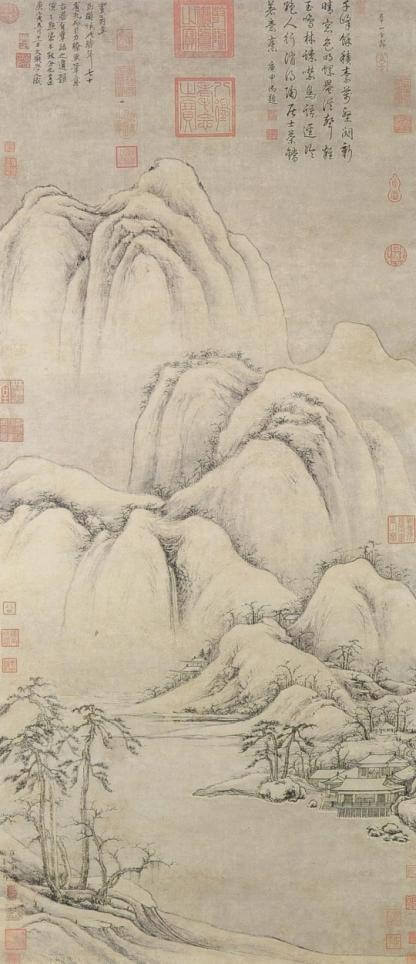 Cao Zhibai's painting "Clearing Snow on Mountain Peaks"Many Chinese paintings that were created during this period by the literati gentlemen abound with allegories to their situation. Rocks withstanding the power of the sea, bamboo rods bending (but not breaking) in the wind, plum blossoms that erupt in spring with snow still on the ground were some of the popularly used symbols for endurance and perseverance at the times of adversity, that the literati aspired to. Instead of fighting back, the educated Chinese gentlemen of that period saw it as their obligation to endure the hardships of Mongol occupation and to wait for better times to come.
Cao Zhibai's painting "Clearing Snow on Mountain Peaks"Many Chinese paintings that were created during this period by the literati gentlemen abound with allegories to their situation. Rocks withstanding the power of the sea, bamboo rods bending (but not breaking) in the wind, plum blossoms that erupt in spring with snow still on the ground were some of the popularly used symbols for endurance and perseverance at the times of adversity, that the literati aspired to. Instead of fighting back, the educated Chinese gentlemen of that period saw it as their obligation to endure the hardships of Mongol occupation and to wait for better times to come.
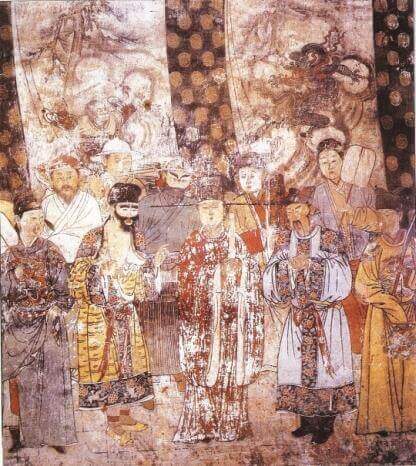 Yuan Dynasty mural showing a group of theatre actors (mural at the Guangsheng Temple, Hongtong county, Shanxi province)Plays and popular dramas that were performed in theatres during this period also allegorically referred to the Mongol occupation by using historical themes (for example the conflict with the Xiongnu people during the Han dynasty), that often dealt with the resistance of the Chinese against alien authoritarian or cultural influences.
Yuan Dynasty mural showing a group of theatre actors (mural at the Guangsheng Temple, Hongtong county, Shanxi province)Plays and popular dramas that were performed in theatres during this period also allegorically referred to the Mongol occupation by using historical themes (for example the conflict with the Xiongnu people during the Han dynasty), that often dealt with the resistance of the Chinese against alien authoritarian or cultural influences.
Even though the Mongols employed political censors, they were often unable to understand the veiled critique of their occupation in the flowery classical Chinese that these plays employed. In that way, the growth in popularity of the Chinese political theatre played an important role in maintaining a certain level of resentment of the Mongol occupiers among the Chinese population.
The Mongol-led Yuan dynasty entered its downward spiral with the death of Kublai Khan in AD 1294. The successive weak Mongol emperors lost the initiative more and more to the resurging Chinese literati class. The Chinese officials in the empire, even at the imperial court itself, increasingly regained the influence that they had lost. When the Mongols reinstated the imperial examination system in AD 1313, it was a quasi-admission by the conquerors to the Chinese literati that China couldn't be ruled without them. By then, the system of holding imperial examinations had been suspended for several decades. The last imperial examination during the period of the Southern Song dynasty had taken place around AD 1270, just one year before the founding of the Yuan dynasty.
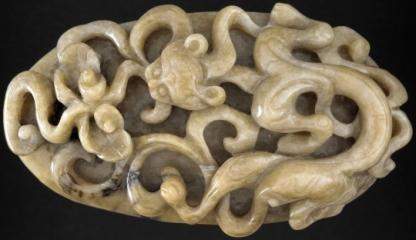 oval buckle plaque with dragon and ruyi scrolls made out of jade or soapstone during the Yuan dynastyEven though they had regained their influence, there was no unity among the literati and instead of using their regained power to influence the governance of China, they soon divided into different factions that supported various Mongol leaders or Chinese literati officials. Personal conflicts arose among the Mongol leaders as well, so that the governance of the Yuan empire became increasingly difficult.
oval buckle plaque with dragon and ruyi scrolls made out of jade or soapstone during the Yuan dynastyEven though they had regained their influence, there was no unity among the literati and instead of using their regained power to influence the governance of China, they soon divided into different factions that supported various Mongol leaders or Chinese literati officials. Personal conflicts arose among the Mongol leaders as well, so that the governance of the Yuan empire became increasingly difficult.
 Yuan dynasty coinsThe fall of the Yuan dynasty was facilitated by the arrival of the great plague that devastated Central China (and particularly the Yangtze River Valley) in the late 1340s. Costing unimaginable loss of lives (up to fifty percent of the population fell victim to the great plague in some parts of Central China), the great plague contributed to a fall in state revenues and considerably dwindled the labour resources in the agricultural areas of the Yangtze River Valley. Eventually, there weren't enough labourers alive anymore to control the wild Yangtze River through the man-made flood-control system and the resulting floods caused further devastation and disease outbreaks in these areas.
Yuan dynasty coinsThe fall of the Yuan dynasty was facilitated by the arrival of the great plague that devastated Central China (and particularly the Yangtze River Valley) in the late 1340s. Costing unimaginable loss of lives (up to fifty percent of the population fell victim to the great plague in some parts of Central China), the great plague contributed to a fall in state revenues and considerably dwindled the labour resources in the agricultural areas of the Yangtze River Valley. Eventually, there weren't enough labourers alive anymore to control the wild Yangtze River through the man-made flood-control system and the resulting floods caused further devastation and disease outbreaks in these areas.
The internal division among both the Mongol rulers and Chinese literati had the effect, that the disease-struck areas received only negligible amounts of medical assistance and disaster-relief efforts from either group. The wealthy literati elite mostly isolated itself from the desperate common people and hoarded resources for their own survival instead of extending a helping hand.
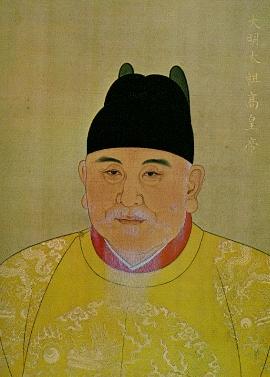 painting of Zhu Yuanzhang, the founding Hongwu Emperor of the Ming dynastySince no help was forthcoming, the poor peasants took matters into their own hands. Many peasant movements sprang up throughout the central and lower Yangtze River Valley as a result. The desperate peasants availed themselves of any resources that they could get their hands on, even through outright banditry if necessary. The only institution that distinguished itself positively during these years of the plague were Buddhist monasteries which provided food, shelter and medical care.
painting of Zhu Yuanzhang, the founding Hongwu Emperor of the Ming dynastySince no help was forthcoming, the poor peasants took matters into their own hands. Many peasant movements sprang up throughout the central and lower Yangtze River Valley as a result. The desperate peasants availed themselves of any resources that they could get their hands on, even through outright banditry if necessary. The only institution that distinguished itself positively during these years of the plague were Buddhist monasteries which provided food, shelter and medical care.
The orphan and smallpox survivor Zhu Yuanzhang (AD 1328 - 1398) benefited from the help and services that the Buddhist monasteries provided as a novice monk and when he was travelling through these plague-struck areas as a vagabond beggar.
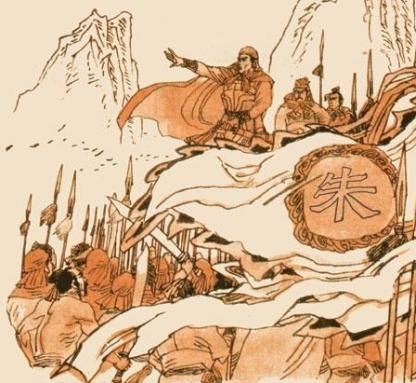 drawing of the Red Turban RebellionDuring this time, he also encountered the popular peasant movements that had mushroomed along the course of the Yangtze River. After joining the group of the Red Turbans, he employed his military skills and intelligence to quickly rise up to a top leadership position. By the early 1360s, he had eliminated his rivals in order to become the undisputed leader of the Red Turbans. Henceforth, he transformed this movement from its mystical roots to an army that sought to overthrow the old Yuan dynasty.
drawing of the Red Turban RebellionDuring this time, he also encountered the popular peasant movements that had mushroomed along the course of the Yangtze River. After joining the group of the Red Turbans, he employed his military skills and intelligence to quickly rise up to a top leadership position. By the early 1360s, he had eliminated his rivals in order to become the undisputed leader of the Red Turbans. Henceforth, he transformed this movement from its mystical roots to an army that sought to overthrow the old Yuan dynasty.
After consolidating their power base in the Yangtze River Valley, the Red Turban army started a series of military campaigns towards their goal and eventually reached the Mongol capital of Dadu in the north of China (the Mongol capital Dadu was located slightly north of the centre of present-day Beijing) in AD 1368.
The Mongols that had already been weakened by the factional infighting among their elite didn't put up much resistance and quickly abandoned their capital in order to retreat across the mountains to their ancestral Mongolian grasslands. After seizing Dadu and bringing the northern areas of China under his control, Zhu Yuanzhang proclaimed the founding of the Ming dynasty (ming = bright) in AD 1368 which he then continued to rule as its Emperor Hongwu (hongwu = vast martial virtue) until his death in AD 1398.
Chinese History Digest's summary of China's history continues with the story of the Ming dynasty in the next chapter, one of the best-known and most powerful dynasties of ancient China.
